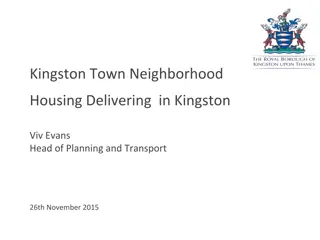Strategic Housing Provision Through Local Planning
Effective local planning is crucial for addressing housing needs and guiding development in the right direction. Having a sound local plan not only ensures quality development but also attracts investment. Housing provision is a significant strategic issue, with the responsibility falling on local planning authorities to set adequate levels based on evidence. Inspectors enforce compliance with the National Planning Policy Framework to ensure plans meet present and future needs. Various areas must be considered, such as flexibility, boosting supply, and using proportionate assessments.
- Housing provision
- Local planning
- Strategic development
- National Planning Policy Framework
- Inspector requirements
Download Presentation

Please find below an Image/Link to download the presentation.
The content on the website is provided AS IS for your information and personal use only. It may not be sold, licensed, or shared on other websites without obtaining consent from the author. Download presentation by click this link. If you encounter any issues during the download, it is possible that the publisher has removed the file from their server.
E N D
Presentation Transcript
Dealing with housing through your Local Plan John Baker October 2013
Why have a plan? To provide for the needs of the community To direct development to the right places and away from the wrong places To achieve development of the right quality To join up the activities of different parties to achieve common objectives To attract investment through the confidence that comes of having a strategy in place
but putting a plan in place means dealing properly with housing provision - which means taking a lead and acting strategically
housing provision not the only strategic issue, but the big one! 250,000 homes needed each year 125,000 homes being provided If the plan led system doesn t deliver, the presumption will!
Providing housing Making provision for housing is a fundamental part of setting a coherent strategy in a good and sound Local Plan Setting the level of provision: is the responsibility of the local planning authority requires evidence
a plan wont be found sound by an Inspector unless it complies with the National Planning Policy Framework and Inspectors are now applying the requirements of the Framework
The NPPF Para 7 - meet needs of present and future Para 14 - positively seek opportunities to meet development needs, sufficient flexibility Para 47 - significantly boost supply, meet full objectively assessed needs, deliver viable sites Para 159 - Use a SHMA, meet the need and demand, identify scale and mix Para 167 - Assessments should be proportionate
Inspectors views requirement is not the same as housing supply (Rother, East Hampshire, Ryedale, BANES, Dacorum) should not include policy judgements (Suffolk Coastal) should use national projections as the starting point (Rushcliffe, Ryedale, Dacorum) should consider the whole of the housing market area (Rushcliffe, East Hampshire, Coventry, Hart , Waverley, BANES) should use a transparent methodology and consider all relevant forecasts (Hull, BANES, North Somerset Judgement) absence of provision for an adequate future supply of housing (N W Leicestershire)
Inspectors views continued Hart Core Strategy Inspectors letter 26 July 2013 Non compliance with duty to cooperate Significant failures with respect to soundness and requirement to identify objectively assessed need Waverley Core Strategy Inspectors Preliminary Conclusions 13 June 2013 Requires a more considered assessment of housing need within the context of the housing market area Expect the Council to take a positive approach Review of policy constraints and designations
Inspectors views continued In order for the Core Strategy to be found sound it must at least set out a policy framework which allows for an adequate supply of housing land over the plan period as a whole and a five year supply of deliverable sites to be identified Wigan Core Strategy Inspectors letter 14 March 2013
Appeal decisions NPPF Para 49 policies are not up to date if there is an identified need and no deliverable 5 year supply. Numerous appeals tested, upheld by Secretary of State which overrule employment protection, settlement boundary, landscape, green space and wedge policies and others. Costs being awarded. - Tarporley Cheshire (APP/P1133/A/12/2188938), - Shutterton Combe in Teignbridge Borough Council (APP/P1133/A/12/2188938) - Basingstoke and Deane (APP/H1705/A/12/2188125 ) and Cherwell (APP/C3105/A/12/2189191) - Ingleby Barwick, Stockton on Tees Borough Council (/APP/H0738/A/13/219538) - Guisborough, Redcar & Cleveland Borough Council (APP/V0728/A/13/2190009)
National Planning Practice Guidance Be based on fact and unbiased evidence To be done at relevant functional area Assists with defining housing market area and identifying sources Must start from ONS / CLG housing projections Must not make local adjustments about migration unless they have the agreement of other LPAs within their housing market area Only test realistic scenarios not consider purely hypothetical future scenarios Supply constraints must not contaminate the assessment of housing need An allowance should be made to reflect past under delivery Increased emphasis given to market signals, land values, prices, affordability Encourages standard methodology to aid transparency Comprehensive assessment only required every 5 years, but regular local monitoring! Considerable detail on how to calculate affordable housing element
Looking at assessing the housing requirement understanding supply and deliverability deciding on the level of provision to make in the local plan unmet requirements and neighbouring authorities
Requirement and provision The requirement must be objectively assessed the provision made through the plan can be different from the objectively assessed requirement any difference has to be very well justified what to do with the unmet element?
The Housing Market Area What is your housing market area? NPPG: The relevant functional area - market based, migration flows and contextual How does your authority area relate to the housing market area (HMA)? What relationship do you already have with neighbouring authorities across the HMA? What information is available for that area?
The SHMA For a housing market area provide evidence of the level, type, size and tenure of housing undertake further detailed analysis as required such as detailed affordable housing needs assessment, analysis of affordability and consideration of sectors of population such as older people
The SHMA continued involve others by taking a corporate approach working across the Council, with key partners, stakeholders and registered providers Information on homelessness, those in temporary accommodation, overcrowded and concealed households and on waiting list in bands A-D Will provide a basis for informing strategies across the Council continuous monitoring
Establishing an objectively assessed requirement Through a comprehensive understanding of what is required to address demographic change and the implications of achievable economic potential in the area to understanding how your population will change over time.
Demographic issues The past allows us to understand the present How did our previous policies shape the population? Is this what we wanted and needed? What would happen if past trends continue ? Projections - are based on the information from the previous five years.
Demographic issues continued Does the projected population profile fit your vision and aspirations? For example - want economic growth but insufficient working age population How can past trends be changed- what policy mechanisms are there to do this? what would the mix of housing be?
Migration people arriving from elsewhere in the UK (internal) and abroad and people leaving to go to other parts of the UK and abroad (international) sensitive and volatile can be varied to test different assumptions not influenced by policy choices - no prospect of zero migration so this would be a wholly inappropriate scenario
Average household size a key assumption is perhaps not falling as fast as previously predicted, but this may be self fulfilling because of the restricted access to suitable housing is very sensitive to small changes
Jobs and Homes Integration between assessment of and strategies for housing and employment (as required by NPPF). But not all demand for homes is created from new jobs - considerable demand coming from existing population. key issue in the North Somerset high court challenge Jobs based calculation are useful to: cross check and corroborate demographic information ensure housing doesn t constrain growth influence distribution of jobs and homes
An employment led approach Understanding the implications of sectorally based achievable economic potential in terms of future job levels: testing up to date employment projections using economic activity rates to convert job growth into the level of population needed to provide the employees required to fill the jobs translating the total population into households according to predicted household size
Taking account of commuting Relationship between authority areas and settlements and implications of current commuting levels Travel to work data - 2011 census release due late 2013 and comparison with 2001 data What level of self containment do your settlement have? Is it possible to reduce out commuting?
approach to seeing the requirement now established by combining demographic and economic scenarios Most credible eg reflecting long term migration trend Demographic scenarios Economic scenarios Most credible eg reflecting sectoral forecasts and committed strategy if economic led requirement greater, take this if lower, use demographic led requirement
Relationship with supply issues Understand the potential supply of housing SHLAA is a separate assessment of suitable sites sets out what is available, suitable, deliverable Used for five year land supply Must be critically assessed to determine realistic potential
SHLAA The SHLAA is an objective assessment of housing that can come forward, with an estimate of when Allowance can be made for windfall if the windfall rate is based on past data is cleaned of any sources appearing elsewhere in the supply contains no double counting of sites with permission in the first few years Common mistakes: assuming development rates ie per site / sales outlet per annum that are higher than development industry agree not factoring in long enough lead in times between sites getting permission and delivering houses
Market capacity and deliverability Understand market signals Understanding completions, as far back as possible by year to assess long term averages - indication of what was possibly under previous policies and in different /better market conditions Use Developer workshops to explore viability issues: understand market areas land and house prices likely build rates market for different types of houses
Reviewing designations and policies Review of: Landscape designations Employment land Settlement boundaries Green belt - Hunston judgement Using Sustainability Appraisal as a key tool to understand the implications of various options
Translating the requirement and supply into a provision target Can the requirement be met? Should the level of provision be different ? inability to deliver what is required inability to fund infrastructure needed to make the place work Factor in policy issues: economic growth, reduction in commuting, high affordable need, green belt, environmental capacity Any difference must be FULLY JUSTIFIED
Where does the unmet requirement go? Effectively a distribution issue To adjacent authorities within the HMA, but what if they: cannot meet their own need are equally constrained Duty to co-operate is a legal test and soundness test ensures working together at the functional area to deliver effective spatial plans Examples - http://www.pas.gov.uk/pas/core/page.do?pageId=2133734
Five year supply Can only be identified once the provision in the plan is set. It is the provision (10,000) divided by the years covered by the plan (20) and multiplied by five, ie 10,000 / 20 X 5 = 2500 To this is added : Flexibility allowance of between 5 - 20% Level above 5% depends on whether there has been a record of persistent under delivery (measured by analysis of completions against previous requirement) Data from last 10 years and evidenced from AMR
Backlog underprovision that has accrued against previous development plan target Two schools of thought: projections take account of all need and any shortfall is reflected v trends reflects low household formation rate and pent up demand should be added Practice Guidance now concludes that household projections do not reflect unmet need, and so evidence of whether household formation rates have been constrained by supply should be considered. How it is addressed in the plan: preferably front loaded using Sedgefield approach v Liverpool (residual) approach
Conclusions Providing the right amount and type of housing as part of a good and sound plan by using: Up to date information across the Housing Market Area Approach must be clear - do not use a closed box method to hide assumptions Realistic assumptions - not based on very low migration, over optimistic economic activity rates or rely on large change in out-commuting Appropriate scenarios and options Ensuring the deliverable supply meets the objective requirement Evidence for and justification of provision figure
Conclusions Consideration of the supply side as a separate exercise Robust SHLAA and assessment of deliverability, viability, market capacity and involvement of developers in the process Housing policies are consistent with economy policies ie the objective to achieve jobs is supported by the delivery of a suitable number of homes Consistency with the logic set out in the SHMA in terms of affordable housing need Regular monitoring of information to review assumptions and assess achievement against key objectives
Dealing with housing through your Local Plan John Baker October 2013























